The Caribbean’s Wilder Side Showcases Magical Jungles, Waterfalls and Wildlife
The Caribbean is famous for its seductive beaches, those bathing beauties that beckon most visitors to this tropical paradise. But the region is also a haven for other natural attractions, from jungle-swathed mountains to lush rainforests to gushing waterfalls to mangrove reserves. You can hike wooded trails, watch whales or birds, bathe in cascades, admire gardens, witness bioluminescence, kayak in lagoons, explore caves and immerse yourself in stunning natural beauty overflowing with tropical flora and fauna.
Generally, the region is split between mountainous volcanic islands with varied terrain and flat coral ones with the best beaches. For nature lovers interested in going beyond the beach, the former are the top islands for exploring a cornucopia of gorgeous natural attractions.
I’ve been privileged to experience many of those wonders of nature myself during a 10-year stint as the founding editor in chief of Caribbean Travel & Life magazine, which enabled me to visit virtually every island in the region. While I do love a good beach, many islands offer so much more of nature’s glory. There’s nothing quite like feeling the rush of a cool jungle cascade, spotting an endangered bird for the first time or being engulfed by the incomparable sparkle of a bioluminescent bay. I’ve come to appreciate the Caribbean’s many opportunities for full-body immersion in its boundless natural beauty. Here are some of the best.
Dominica
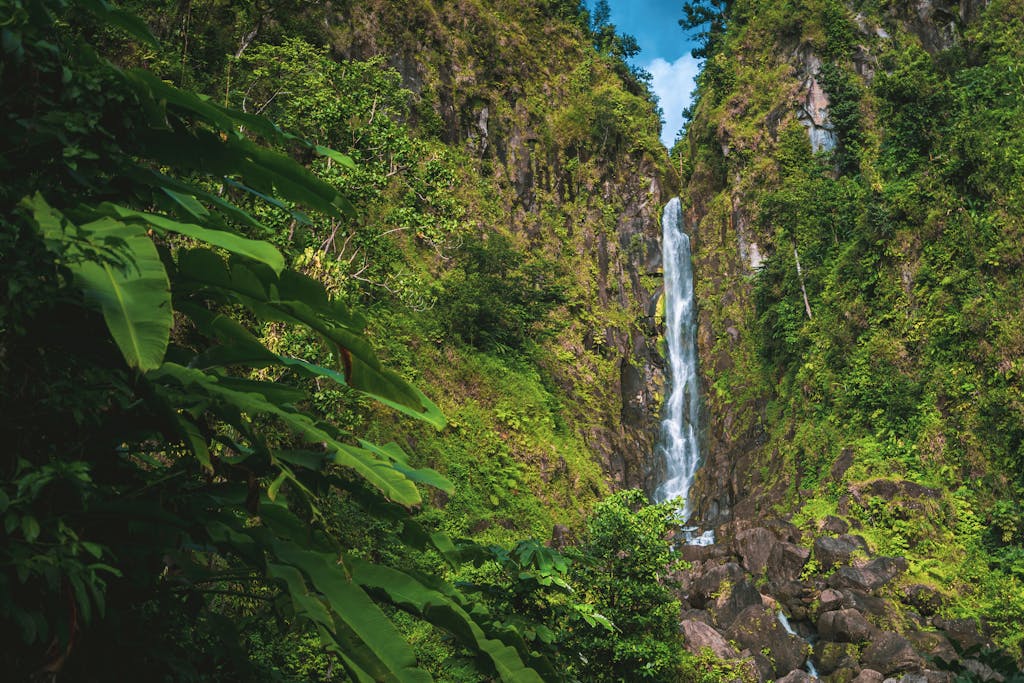
A Caribbean eco-tourism superstar, Dominica comes by its slogan “the Nature Island” honestly. Outdoor lovers can explore pristine tropical rainforests, admire wondrous waterfalls, climb towering green mountains, hike through an active volcanic caldera to the world’s second-largest boiling lake, rappel through deep river gorges, and trek a 124-mile national trail — all on one island. Plus, they can spot 197 species of birds, including two endemic parrots — the imperial parrot, called the Sisserou, and the red-necked parrot, or Jaco — and four species of iridescent hummingbirds.
In the surrounding waters, they can search for 16 species of sea mammals — especially the sperm whale, the largest of all the toothed whales and star of Moby Dick. No wonder Dominica has earned the title of Whale Watching Capital of the Caribbean. There’s such a wealth of natural attractions, in fact, that Silversea offers a whopping nine shore excursions to showcase them.
Start with the 17,300-acre Morne Trois Pitons National Park, a UNESCO World Heritage Site. According to UNESCO, “it has it all: volcanic fire, boiling lakes, hot springs, deep valleys, freshwater lakes … 50 fumaroles and huge biodiversity,” which features five types of forest: dry scrub woodland, rain, lower montane, montane and elfin. A primordial, otherworldly landscape, the park is studded with such dramatic landmarks as the Valley of Desolation, an area of boiling mud ponds and geysers; the Boiling Lake, a huge cauldron of bubbling water; the narrow and deep Titou Gorge; and the Emerald Pool, whose swimmable waters get their surreal verdant hue from the fern-filtered sunlight. One of the most popular tourist spots is Trafalgar Falls, three spectacular waterfalls cascading over a precipitous cliff into rainforest-swathed pools below. Inhale the aroma of ginger plants and admire the beauty of vanilla orchids around you.
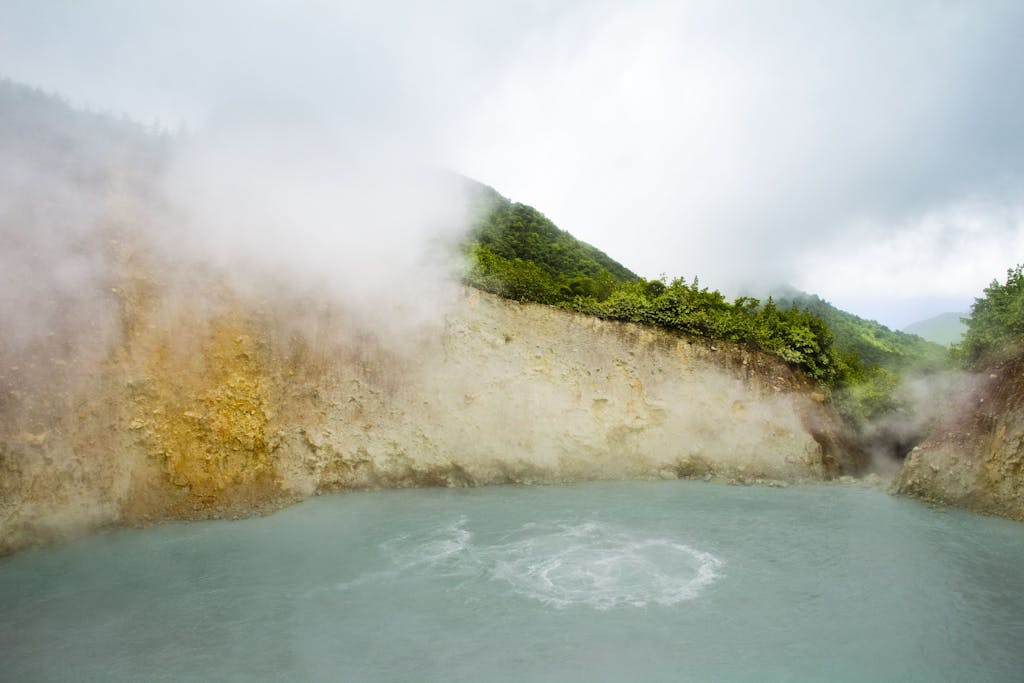
Within the national park, Dominica’s signature hike is the Boiling Lake Trail, a full-day, round-trip challenge that penetrates the dense rainforest, passing along a mountain peak, an active volcanic caldera, and warm-water rivers and cascades. Among Dominica’s four other lakes is its largest, the Freshwater Lake, which is threaded with trails that reveal showy bromeliads, colorful heliconia, large-leaved anthuriums and delicate ferns.
There is a saying that Dominica’s soil is so fertile, if you stand still for long enough something will grow on you. With such exuberant vegetation, it’s no surprise that Dominica boasts two botanical gardens. At the 40-acre Dominica Botanical Gardens you can see the endangered Sisserou and Jaco parrots in protective cages, as well as the flaming-red bois kwaib, Dominica’s national tree and flower, amid other tropical trees and exotic blooms. Meanwhile, at the 14-acre Papillote Tropical Gardens, a profusion of aroids, begonias, bromeliads, gingers, heliconia and indigenous orchids form a lavish botanical tapestry under a verdant canopy.
Grenada

A tiny jewel box of an island, Grenada is a lush paradise laced with a profusion of cocoa and spice plantations that inspire its nickname, “the Spice Isle.” Perfumed by cloves and nutmeg — it’s the world’s second largest producer of the latter — it beckons adventurers with its thickly forested mountainsides and romantic waterfalls. An abundance of rain helps keep the forests teeming with flora and the rivers and streams rushing down the mountains to the sea.
Waterfall aficionados will enjoy two of Grenada’s best: Annandale Falls, a short drive from the capital, where a wall of water gushes over the rocks covered in soft ferns and other vegetation, is surrounded by gardens alive with tropical flowers and trees. And Concord Falls, where you can hike through the forest to the 100-foot cascade and swim in the small pools below.
More ambitious adventurers will love the hiking trails through the Grand Etang National Park and Forest Reserve for a chance to spot mischievous mona monkeys swinging through the mahogany and giant gommier trees. A multitude of ferns, wild orchids, heliconia and tropical flowers provide dense shelter for a wide variety of animal and bird species. You can add these to your life list: broad-winged hawk, Lesser Antillean swift, Antillean euphonia, purple-throated Carib, Antillean crested hummingbird (known as the “doctor bird”), yellow-billed cuckoo and lesser Antillean tanager. Frogs, lizards, opossums, armadillos and mongoose also vie for your attention. Hikes in Grand Etang range from easy 15-minute jaunts to more demanding treks, such as Silversea’s two multi-hour-long excursions.
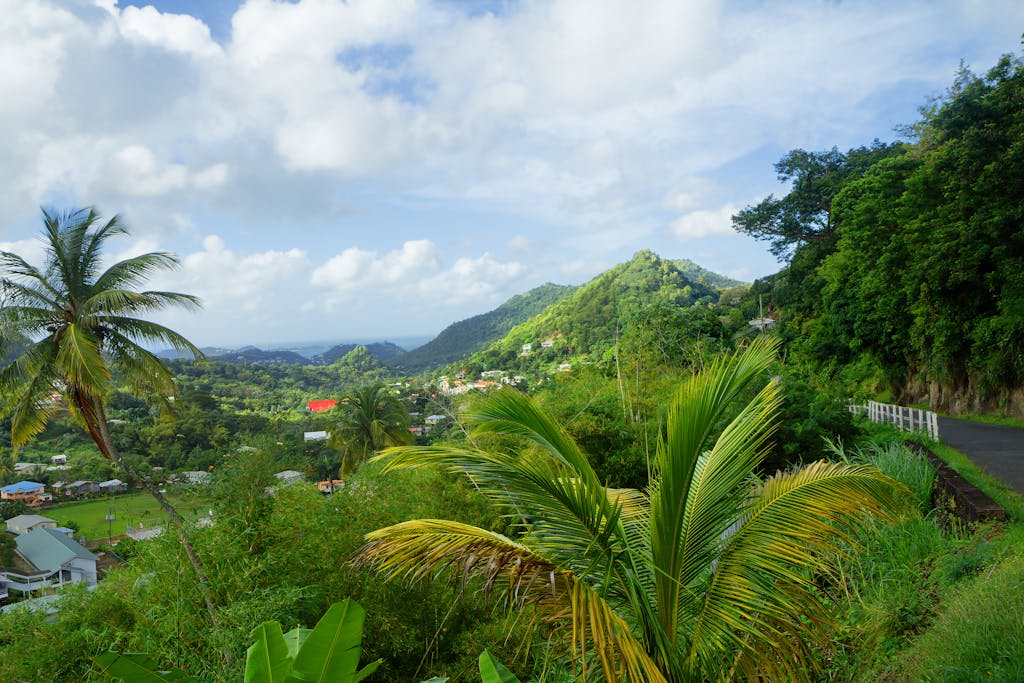
For a coastal habitat, head to the 450-acre Levera National Park where the seagrape-fringed beaches are a hatching ground for sea turtles. Its lagoon is one of the largest, most productive mangrove swamps on the island where birdlife includes black-necked stilts, common stripes, herons, waterfowl and migratory warblers.
Grenada’s sister island of Carriacou may be tiny, but it counts a significant natural attraction: the Petit Carenage Sanctuary Nature Trail. This sea-level path winds through the Mangrove Restoration Project to the Bird Watch hideout, which promises a dramatic view of the northern Grenadines archipelago. Resident and migrating wetland and forest birds thrive in the tidal pond and more than 42 species of birds reside in the sanctuary. The marked trail passes along a sea turtle nesting beach, which is included in a Silversea excursion. You can explore 955-foot High North Peak, the highest point in the Grenadines, on a Silversea guided hike to see more than 130 species of plants, as well as reptiles, mammals, resident and migrating birds, crustaceans and insects.
Guadaloupe
Guadeloupe’s natural beauty and diversity of attractions readily rewards any nature lover. Rainforests, elfin woodland, gorges, rivers, mangroves, hot springs, botanical gardens and some of the highest waterfalls in the Caribbean all inspire the innate adventurer. This French island is actually two parts shaped like a butterfly: mountainous Basse-Terre on the west and flatter Grande-Terre on the east.

The 74,000-acre Guadeloupe National Park covers one-half of the total landmass in Basse-Terre, with the brimstone-belching 4,800-foot-high La Soufrière volcano as its headline attraction. Known locally as the Old Lady, it last erupted in 1976. Fifty shades of green from giant trees, ferns, strangling vines and tangled roots swath the trails that penetrate deep into the forest. You can soak in hot springs heated from the very heart of the volcano and cool off in two popular waterfalls: Carbet Falls and Crayfish Falls. Near Carbet Falls, bird watchers flock to the footpath around Grand Etang lake, one of the park’s bird-watching meccas.
For a more planned environment, visit the carefully maintained 17-acre Botanical Garden of Deshaies on Basse-Terre. Its paths reveal the brilliant colors of ginger, bougainvillea, hibiscus, orchids and other tropical vegetation as well as pink flamingos, parrots, lorikets, hummingbirds, butterflies and insects among more than 1,000 species in 15 garden areas.
In contrast to Basse-Terre’s volcanic heights, flat, limestone Grand Terre offers karst and mangrove habitats. You can kayak the Grand Cul-de-Sac Marin, a UNESCO Biosphere Reserve lagoon with the most extensive mangroves on the island and home to herons, frigates, egrets and other tropical birds, as well as 255 species of fish, turtles, shells, crustaceans and reptiles.
Martinique

Despite being mostly volcanic rock, Martinique’s surprisingly diverse landscape features dense rainforests and flowing meadows, gentle hills and bone-dry deserts, jagged peaks and alluvial plains. Its profusion of brilliant tropical flowers appropriately inspired its Carib name, Madinina, which means “Island of Flowers.”
Fully two-thirds of this French island is designated protected parkland, which includes 27 well-marked trails that range from 30-minute walks to grueling nine-hour hikes. Most of that land falls under the protection of the Martinique Regional Nature Park, which was the first reserve of its kind to be created on a tropical island, in 1976. A collection of protected areas scattered all around the island, the park is a paradise for hikers and nature lovers. Its authority covers three main areas and their surrounding forests: the iconic Mount Pelée volcano, whose multi-hour hike to the top promises showstopping views of neighboring islands; the rugged Pitons du Carbet, a mountainous rainforest areathick with tall ferns, anthuriums, heliconia and bamboo; and the Caravelle Peninsula Nature Reserve, whose landscape ranges from grassy savannah to mangroves and which shelters birds such as sucriers, Antillean crested hummingbirds, Martinique orioles and white-breasted thrashers.
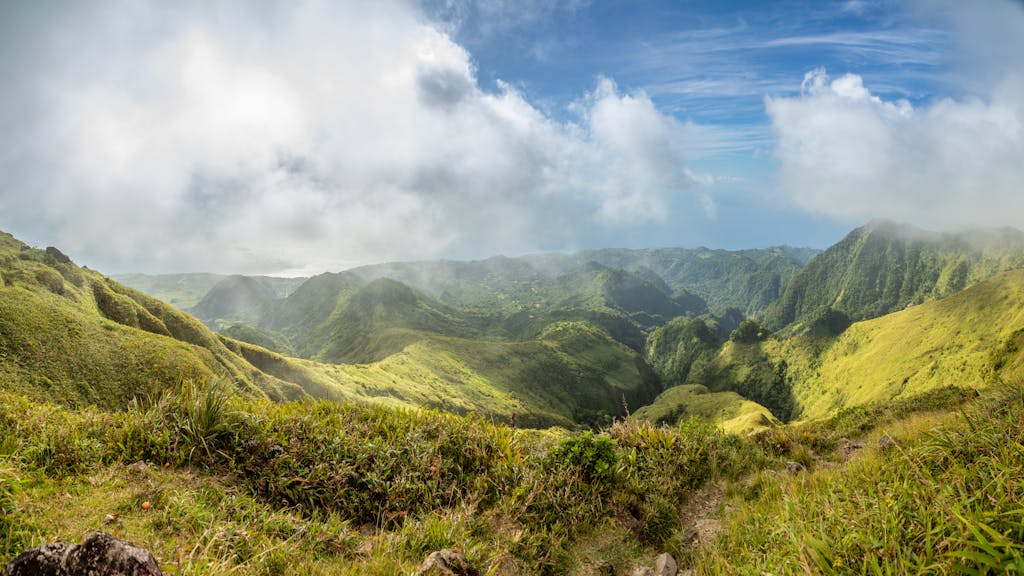
The regional nature park also oversees several other noteworthy highlights. For example, Martinique’s rich flora and fauna are on full display in the excellent Jardin de Balata botanical garden. Featuring thousands of tropical plants as well as fish ponds punctuated with water lilies and lotus blossoms, the garden is threaded with easy walking paths. A perfect complement to the garden is the Domaine d’ Emeraude, a 54-acre wooded area with three miles of walking trails that reveal a hundred plant species. The sharp-eyed can spot iguanas in their natural habitat.
Silversea also offers a guided trek near the capital of Fort-de-France through a biodiverse rainforest flecked with small waterfalls and a multitude of botanical species on its way to the Absalon Hot Springs.
Montserrat
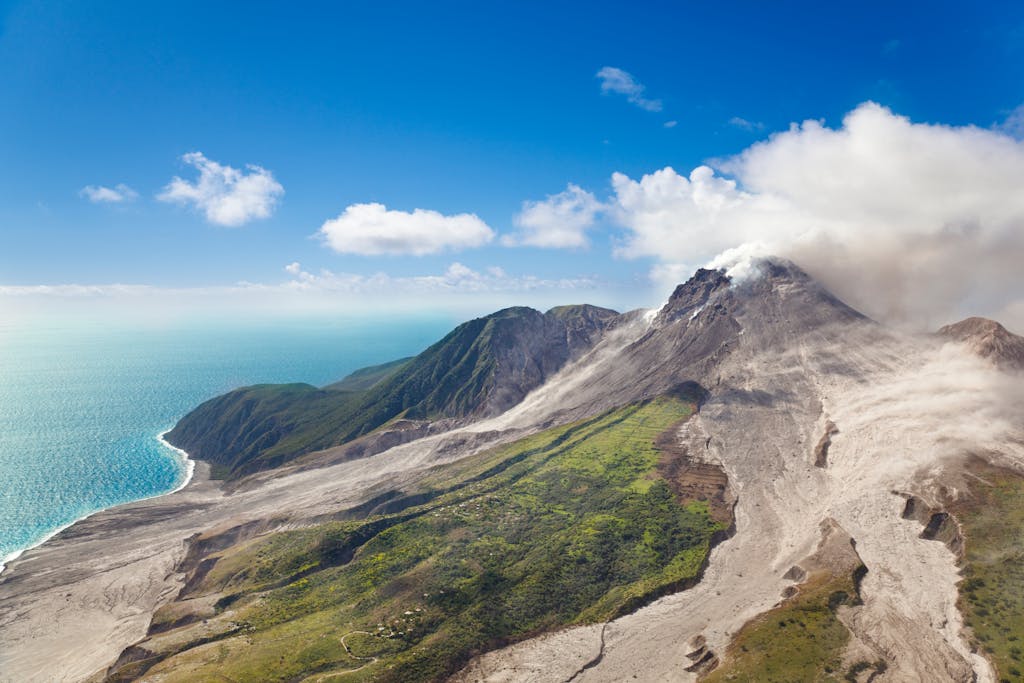
Montserrat’s original nickname, “the Emerald Isle of the Caribbean,” derived not only from its intensely green landscape reminiscent of Ireland, but also from its early Irish settlers. More recently, however, this British Overseas Territory has earned the sobriquet, “Pompeii of the Caribbean,” for having endured more volcanic eruptions than any other island thanks to the mighty Soufrière Hills volcano, which devastated the island in 1995 and continues to spew sulphur and smoke today.
Numerous footpaths and trails, many used for centuries, cross-cross the mountainous island, providing for a variety of hikes of varying difficulty, length and scenery. The Oriole Walkway (two hours each way) is the island’s most popular hiking trail and offers a good chance to see and/or hear the critically endangered national bird, the Montserrat Oriole. Another easy option is the Duberry-Cassava trail, a 45-minute hike with mostly gentle slopes through dry forest.
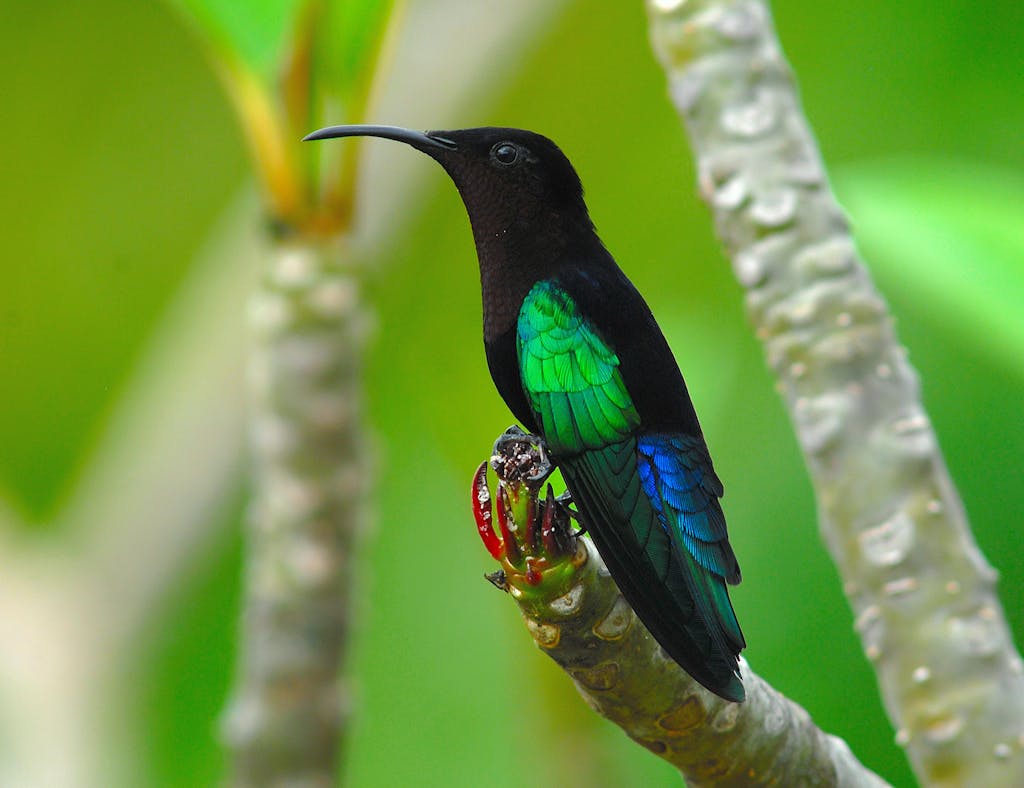
Despite its small size, Montserrat has a wealth of bird habitats. The Centre Hills is one of the best birdwatching spots in the Eastern Caribbean, where life listers will thrill to spot the iconic Montserrat Oriole, as well as three species of hummingbirds, bridled quail-doves, scaly-breasted and pearly-eyed thrashers, yellow warblers, scaly-necked pigeons and other species. Silversea offers a guided trek along nature trails in this region as well as a birding excursion on the renowned Oriole Walkway.
Silversea also offers a tour of the Botanical Garden, created by the Montserrat National Trust to spotlight the importance of local vegetation. Its orchid house showcases the island’s endemic orchid, among others.
From May to December, you can also watch green, leatherback and hawksbill turtles lumber ashore to release their eggs along several island beaches, including Old Road Bay, Isle’s Bay, Lime Kiln Bay, Woodlands Beach and Bumkum Bay. It’s a sight to behold!
Puerto Rico

Puerto Rico is blessed with a richly varied landscape that includes two rugged volcanic mountain ranges, the Sierra de Luquillo and the Cordillera Central, causing nearly one-fourth of the island to be covered by steep slopes; a 4,390-foot-high peak, Cerro de Punta, the island’s highest; tropical rainforests; rivers, streams and waterfalls; bioluminescent bays; and karst country honeycombed with sinkholes and caverns.
Hundreds of miles of hiking trails lace the island’s 36 nature reserves and 19 state forests. From easy walks to tougher mountain treks, they offer great bird watching opportunities for Puerto Rico’s 376 avian species.
The crowning glory of the system of national parks and wildlife sanctuaries is the Caribbean National Forest in the Sierra de Luquillo southeast of San Juan, familiarly known as El Yunque. The only tropical rainforest in the U.S. National Forest System, this 28,000-acre emerald expanse is dotted with idyllic waterfalls and covered in dense flora, including rare species of orchids. It’s also home to some of Puerto Rico’s most endangered animals, such as the small green Puerto Rican parrot, among nearly 100 species of birds. Ribboned with the island’s best trails, El Yunque’s verdant forests and steep peaks are ideal for hiking and mountain biking. Keep your ears open for the insistent sound of the coquí, a tiny frog considered a national symbol whose name derives from its onomatopoeic call: “co-kee”.
Looking for a bioluminescent lagoon, mangroves, coral reefs and dry forests all in one place? Then head to the small Cabezas de San Juan Nature Reserve, just outside the town of Fajardo, the only place on the island where seven distinct ecosystems overlap. In addition to witnessing the diverse bird species, iguanas and marine life that inhabit this reserve, you can thrill to the magical waters of the bioluminescent Laguna Grande. Watch the sparkling swirls of water, glowing with dinoflagellate, the tiny organisms that create the dazzling bioluminescence.
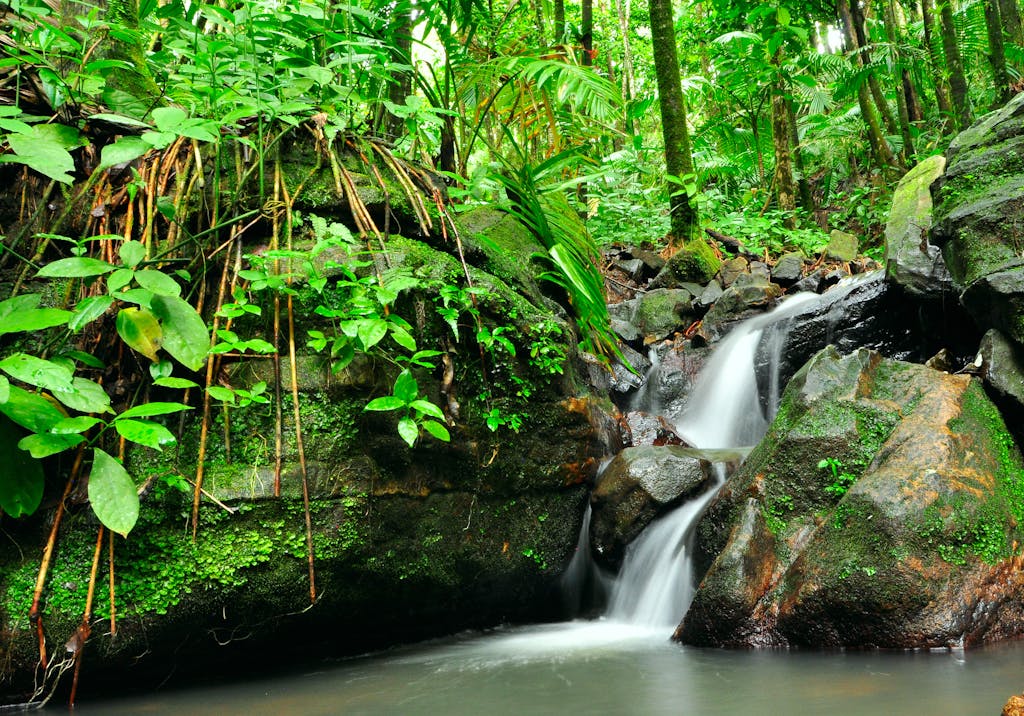
Fifty-six miles west of San Juan the landscape is pockmarked with one of the best tracts of karst country in the entire Caribbean, mottled with limestone hummocks, sinkholes, caves and jagged rocks. The remote Guajataca Forest Reserve offers the best example of this dramatic landscape full of extensive footpaths and an observation tower. The north coast also boasts the Western Hemisphere’s third-largest subterranean cave system carved out by the world’s third-largest underground river, the Camuy River. Prepare to be wowed by the drama of Camuy River Cave Park’s more than 10 miles of caverns and 220 caves, some with ceilings more than 10 stories high.
For another unique experience, strap on your hiking boots and head for one of the 12 trails of the Guánica Dry Forest, a 9,000-acre UN International Biosphere Reserve that’s one of the most extensive tropical dry coastal forests in the world. Keep a lookout for the more than 600 species of flora and fauna and about half of all Puerto Rico’s bird species. More vegetation-trimmed trails await in two forest reserves in the south: the Toro Negro Forest Reserve and the Maricao Forest Reserve.
Just east of San Juan along the coast is the Piñones Forest, the largest of Puerto Rico’s mangrove forests. Along its trail, you’ll find reefs, seagrass meadows, salt flats and dunes.
St. Lucia
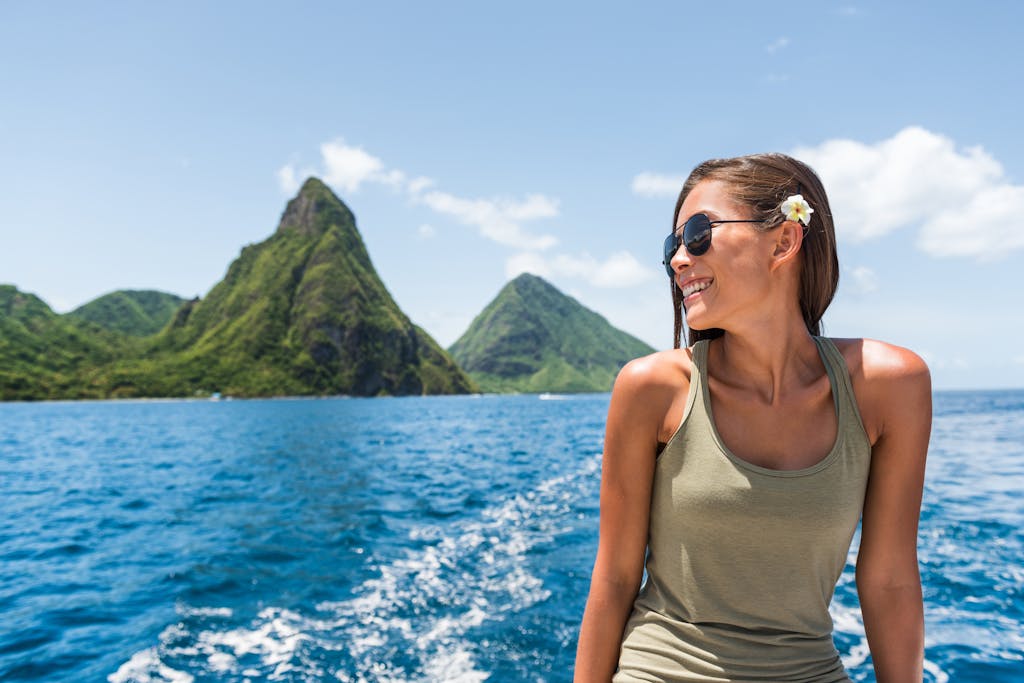
The only sovereign nation to be named for a woman, St. Lucia is such a natural dazzler that St. Lucian Nobel Laureate, Sir Derek Walcott, was inspired to say, “There’s beauty, and then there is St. Lucia.” The island also stands out for one of the most dramatic landmarks in the Caribbean: the twin peaks of Petit Piton and Gros Piton, which rise precipitously out of the sea 2,600 feet like giant green gumdrops. Covered with thick tropical vegetation, the massive volcanic outcroppings are climbable, but only by the hardiest.
For more accessible hikes, head to the spectacular Rain Forest Walk in the National Rain Forest, home to the highly endangered St. Lucia parrot, called Jacquot, as well as four other endemic birds: the St. Lucia warbler, St. Lucia black finch, St. Lucia peewee and St. Lucia Oriole. The forest also shelters the island’s most infamous land creature, the fer-de-lance, a poisonous pit viper locally called “the serpent.” A trek through the dense forest vegetation reveals a tapestry of fragrant wild ginger, ferns, bromeliads, orchids, magnolias and anthuriums, bursting with color. Silversea offers two showstopping ways to soar over the rainforest canopy: on a leisurely glide by gondola and on an exhilarating zipline flight.
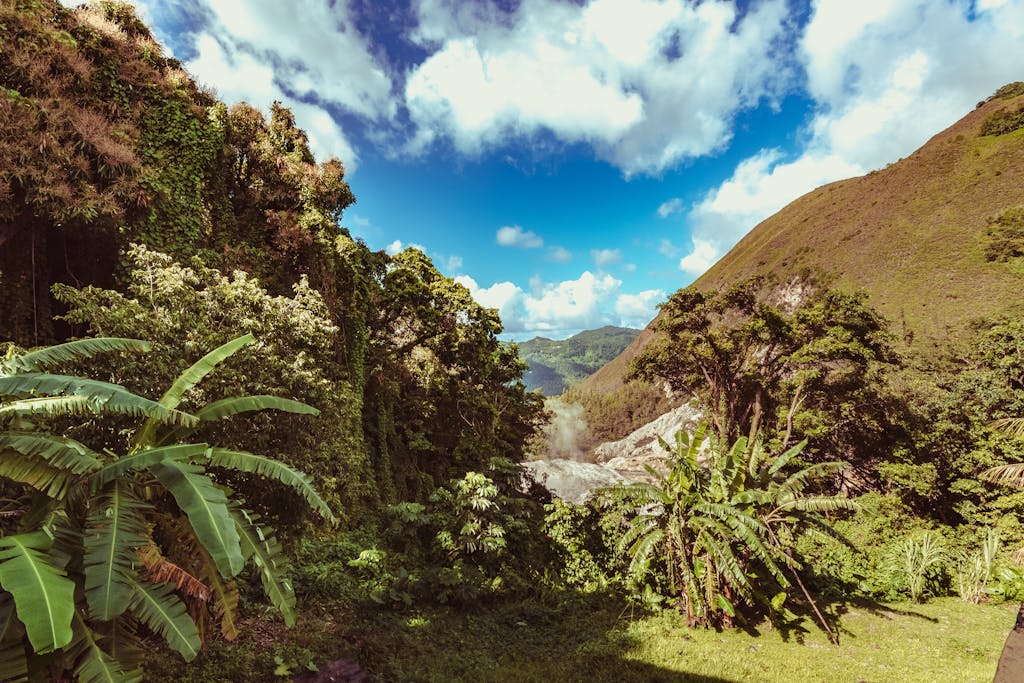
St. Lucia also counts among its natural wonders the world’s only “drive-in” volcano, the dormant Soufrière, and the world’s rarest snake, the endemic St. Lucia racer. Marvel at the burbling hot Sulphur Springs in the volcano’s caldera where you can enjoy a mud bath. Nearby is the Diamond Falls & Botanical Gardens, a six-acre retreat where age-old baths are filled with therapeutic waters and lush tropical flora and fauna abound.
St. Vincent and the Grenadines
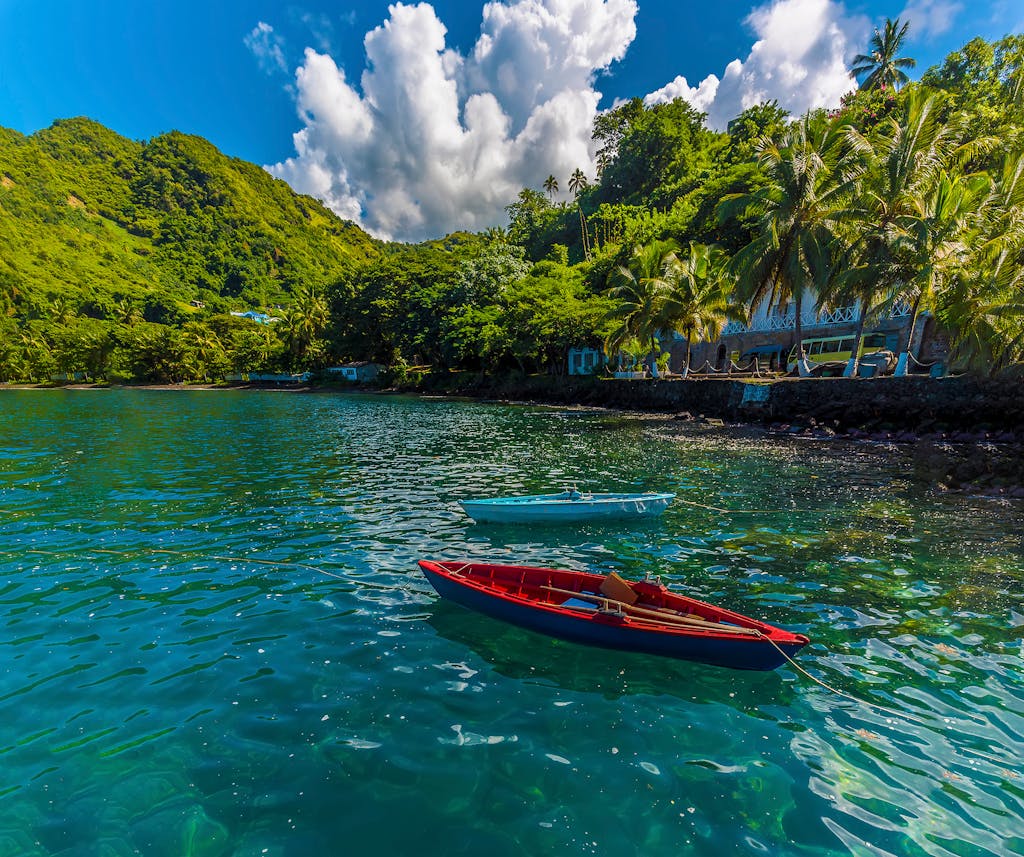
Nature’s exquisite beauty is still largely untouched by development in St. Vincent and its string of Grenadine Islands. Visitors can trek to an active volcano, take a jeep safari into an isolated forest, bathe in a secluded waterfall and relax in a historic botanical garden.
As in other volcanic Caribbean islands, St. Vincent is dominated by its own La Soufrière volcano. The 4,000-foot-high crater was active as recently as March 2021, spewing gas, steam and ash and discouraging hikers for the near future. But they can head instead to the Vermont Nature Trail. A network of loops through the Grand Bonhomme Mountain in the south, it cuts a path through the island’s dense tropical rainforests and wandering streams. Reward yourself with a dip in one of the cool pools created by Trinity Falls deep in the forest. And consider yourself lucky if you spot one of the 500 remaining St. Vincent Parrots flying across the forest canopy.
In fact, St. Vincent will not disappoint birders. Hummingbirds, whistling warblers, Antillean crested hummingbirds, purple-throated Caribs, lesser Antillean tanagers, brown tremblers and rufous-throated solitaires can be spied along the trails. Of the 170 species of resident and migratory birds recorded on the island, many inhabit the coasts, ponds and mangroves, such as magnificent frigatebirds, white-tailed tropic birds, terns, egrets, herons and the occasional glossy ibis.
Just outside of the capital, Kingstown, is the 20-acre St. Vincent Botanic Gardens. Founded in 1765, they are the oldest of their kind in the Western Hemisphere. Among their wide variety of tropical trees and shrubs is a breadfruit tree from the original 50 brought to the country by Captain Bligh (of The Bounty fame) in 1793. But you can also enjoy such showy, jewel-toned flowers as flamboyants, yellow pouis, frangipanis, jacarandas and African tulips.
On nearby Bequia, the largest of the Grenadines, learn all about the endangered hawksbill turtle at the Old Hegg Turtle Sanctuary, created by a local conservationist. Silversea offers excursions to the sanctuary, which is active in saving these denizens of the deep.
Tobago
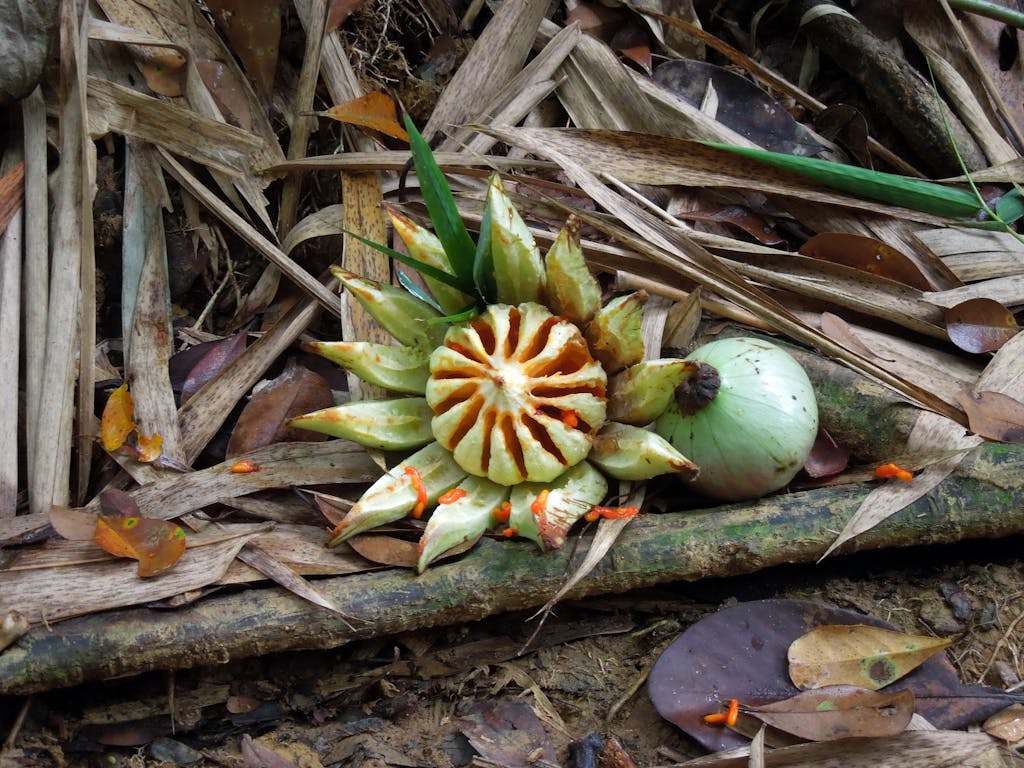
The smaller half of the twin-island nation of Trinidad and Tobago, this tiny, rugged island boasts a Caribbean first: the oldest protected rainforest in the Western Hemisphere, the UNESCO-listed Tobago Main Ridge Forest Reserve. Not surprisingly, it’s nirvana for bird watchers with more than 260 species. A number of trails embroider the reserve, protected since 1776, such as the oldest and most popular Gilpin Trace. Keep your scopes ready here to spot the world’s rarest hummingbird, the neon white-tailed sabrewing, and the gorgeous ruby-topaz hummingbird, as well as fuscous flycatchers, blue-backed manakins and white-necked jacobins.
More birds await at the Miss Mills Trace in the Main Ridge Forest Reserve, such as the endemic Trinidad motmot, the streak flycatcher and others. Thrill to Tobago’s nocturnal species — the white-tailed nightjar and, for the very lucky, the striped owl — on Flagstaff Hill, which is a hotspot for sunset views of the village of Charlotteville.
Birds aren’t Tobago’s only come-hither creatures. Between March and September you can witness giant leatherback turtles lumber ashore to nest each year. Watch them emerge from the water under cover of darkness to lay their eggs at such nesting sites as Turtle Beach, Grafton Bay and Stone Haven Bay.
Hikers will not want for scenic trails through the island’s rolling hills and forest-covered terrain, punctuated by refreshing waterfalls and abundant flora and fauna. The adventurous will be wowed by a kayak tour through the mangroves and along the coastline to witness the magical bioluminescent display of glowing plankton, some of the ocean’s smallest but most dazzling organisms.
